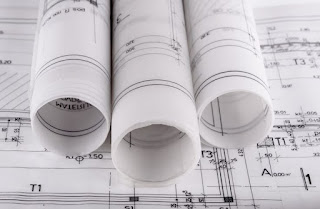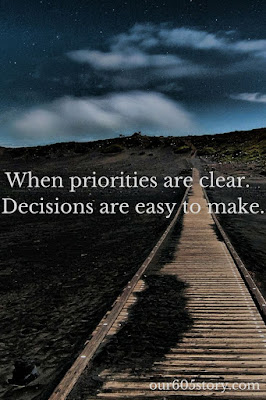In 2006, my husband and I decided to build our forever home on acreage in the rural county in which he grew up. We bought house-plan magazines, checked out house-plan books from the library, and for weeks and weeks pored over various plans, trying to find the perfect floor plan.
 |
| (photo courtesy of Pinterest) |
The longer we searched, the more frustrated we became. We wanted home smaller than our very large 2-story house, one that would certainly have a bedroom for each of our children but that was designed in a way that, once our son and daughter left home, would fit and be practical for just two people.
One Saturday while my husband was at work, I asked my daughter for a few pages of graph paper from her math binder, sharpened a couple of pencils, and began designing a house plan that incorporated everything we wanted.
A few months later, and many erasures and additions to that original plan, a grizzled part-time-farmer and part-time- backhoe-operator dug out the basement for that house. Forms were put in place and concrete poured. We spent the next three years building our house. And when I say “we”, that’s exactly what I mean. My husband and I helped with the concrete work, the framing, and even the installation of the trusses; after that, the professionals left, and my husband — with help from me — built the rest of the house. From flooring to roof, plumbing to electrical, everything was done by us as time and money allowed.
I learned so much from that experience, and I was reminded of principles I had learned as a child but had either forgotten or about which I’d become complacent.
One key principle I was reminded of and also learned in a new, very real way is the importance of creating a good blueprint before starting new construction. And as a homeowner for over 30 years, I’ve learned it’s equally important when remodeling an existing structure as well.
The same is true when redesigning your life. A blueprint, a plan to work from, is essential.
So how do you create such a blueprint after a major life change?
Through trial & error and lots of frustration & false starts, I found a technique that worked for me. Over the past few years I’ve shared this with others who have asked how I’ve gotten to where I am now; every person who has tried this has told me later it helped them immensely.
What worked for me may not work for you, of course, but I hope you’ll give it a try. So grab your favorite planning tools — paper and pen, computer, iPad, etc — and a nice tall glass of your favorite beverage.
There’s no right or wrong timetable for working through this process, this first step in designing your new life. It took me months. Months of jotting lists, putting ideas into practice, and then making revisions. A dear friend accomplished this first step in an afternoon, while relaxing by her apartment-complex pool, and five years later, she continues to live by the blueprint she created that day. Work through this step at your own pace.
Creating a Life Redesign Blueprint
1. Determine your true priorities.
I know, I know. You already know what your priorities are. Or do you? Let’s find out. Right now, jot down a list of the priorities and/or values that you believe govern your life. When I started this process, I jotted down the following: “God, family, others, career, self”. It was the list I had kept at the front of my day planner for years and that I had successfully convinced myself governed my life.
Tear it up. In tiny pieces. Throw them away.
It’s time now for you to determine not what you think your values are and not what you’ve been told they should. It’s time to discover what they really are. How do you do that?
a. Look at your calendar for the past year. If you keep one, look at your planner. On what activities do you spend most of your time?
b. Look at your checkbook register or your bank statement. Where do you spend most of your money? Convert the dollar amounts to percentages. What percent of your money is spent on housing (mortgage/rent, utilities, etc), entertainment (cable/satellite package, trips, etc), charity, family, yourself, and so on?
c. If you are on social media, go back and look at your posts. Consider also your conversations with family and friends. What do you talk about the most, particularly before your life-changing event?
d. If you feel comfortable doing so, ask family and friends (one on one) what they think your priorities are, based on what you do and say.
What you spend your money on, what you spend your time doing, and what you talk about is a pretty good indication of what your true values are. So study your habits and create a list of the priorities that you have actually been living by.
2. Honestly determine whether the priorities you have been living by are the same priorities that you want to govern your life moving forward.
Are you perfectly okay with the values/priorities on your list and the order in which they are ranked? If so, wonderful! You are already on the right track.
 |
| (photo courtesy of Pinterest) |
But what if you aren’t perfectly — and I mean 100% — okay with what is on your list and/or the order in which they are ranked? What if you are a not happy with how you’ve been spending your time and money and what you spend most of your time thinking and talking about?
That’s wonderful, too! Oh, it may not feel wonderful. I know that
when I completed this activity seven years ago, I was disappointed — even regretful and embarrassed — by what I learned about myself. I thought about the time and money I had wasted and about how I had, in at least some ways, been a total fake and hypocrite.
And that’s okay. Face the truth. Forgive yourself if need be, and focus on the positive here:
You’ve learned what’s important to you and are now ready to take the next step in designing your life around your true priorities and values.
We’ll talk next Wednesday about how to do just that.
In the meantime, please share your thoughts below. What did you learn, through this activity, about your priorities/values and, by extension, yourself?
